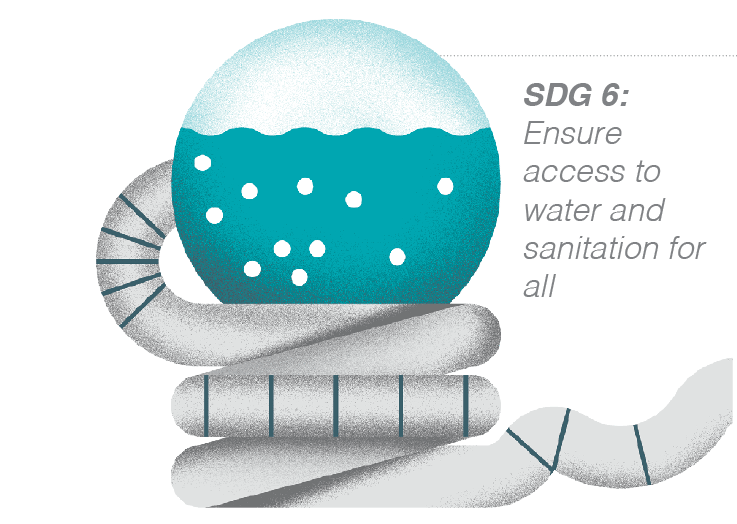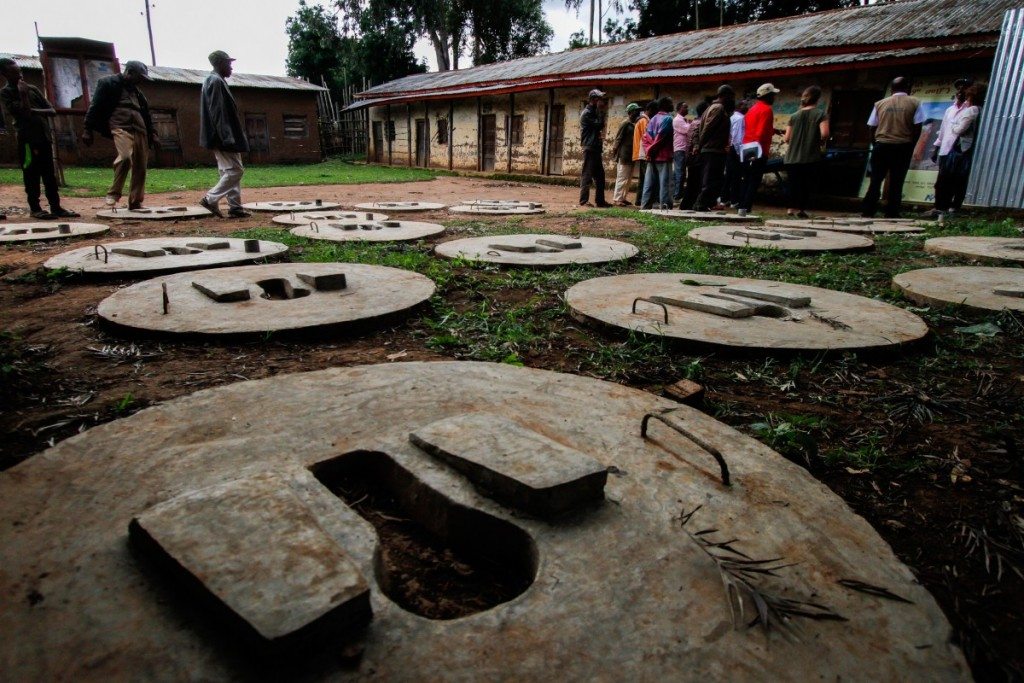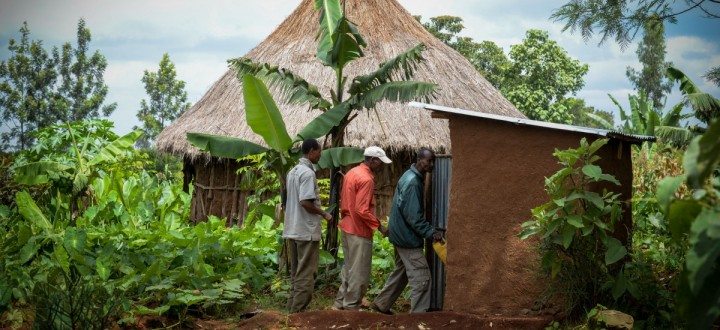 “Excuse me. May I use your toilet?”
“Excuse me. May I use your toilet?”
Despite my not being a paying customer, the restaurant owner directed me toward a doorway at the back of the building. Through the doorway, a woman shucking corn pointed me towards a tarp draped over a piece of wire, less than 20 feet away. I pulled back the ripped tarp to find the toilet—a hole in the ground swarming with flies.
This is what the development community calls “unimproved sanitation,” but what for 71 million Ethiopians is simply “the toilet.” I had just spent the past three days visiting sanitation projects as part of an assessment of global pro bono support for health initiatives worldwide, and had seen both rundown and brand new sanitation solutions. This particular toilet was not one of the site visits on our schedule. I just really had to pee.
Far too often, development professionals sanitize the discussion of toilets and excrement, using industry jargon—like “sanitation”—to euphemize a messy topic. But as I braced myself and lowered myself over the hole, my feet sinking into what I feared was a mix of mud and feces, I realized just what a tricky (and icky) business sanitation can be. My heart raced as I peered through the holes in the tarp, wondering who might be able to see me. I briefly considered standing up to search for a better option—the side of the road, which had previously seemed unreasonable, now seemed preferable. But I had already been holding it for far too long. It was now…or…now.
As I exited the restaurant, I thanked the owner for his hospitality, ashamed of my discomfort just a few moments before. I could count on one hand the number of times I had to use a facility like this one. “Get over it,” I thought, critically. The truth, however, is it also often feels necessary to sanitize our thoughts and feelings about toilets in practice as well. We expect our expansive comfort zones—our “rugged global flair”—to let us work everywhere, eat anything, and go anywhere without reluctance or judgment. Squatting over that hole behind the tarp, however, my comfort zone was 3000 miles away.
But without speaking honestly about the realities of “waste management,” emphasizing instead the bright, shiny, (and clean) sanitation solutions on display, it can be hard to find the root of the issue. The negative impact of unmanaged excrement on communities is far-reaching. The absence of improved sanitation means that toilets like the one behind the restaurant can easily contaminate nearby water sources that are used for cooking and washing. Millions of children who suffer from water-born parasites experience persistent sickness that often keeps them out of school, limiting their learning and economic potential. Even worse, diarrhea caused by unsafe water and poor sanitation is the second biggest killer of children under five worldwide. As I watched the woman preparing food just a few feet away, I realized such contamination happens all too easily.
Economic Growth Doesn’t Always Come a la Commode
Unlike many countries in sub-Saharan Africa, Ethiopia is projected to meet all eight of the Millennium Development Goals by the end of 2015, enormous progress for a country that previously had some of the worst human development indicators in the world. This can be attributed primarily to two factors: Ethiopia, the largest recipient of international donor aid in sub-Saharan Africa, has made good use of these funds. Simultaneously, the government has also made significant investments—largely funded by soft loans from China—in infrastructure, education, health, and agriculture that have spurred economic growth. Ethiopia is the world’s fastest growing economy, yet also one of the poorest countries. While Ethiopia’s GDP has reportedly risen at seven to eight percent a year, its per capita income remains among the lowest in the world. And despite increased economic focus on manufacturing, textiles, and energy generation, agriculture still accounts for 45 percent of gross domestic product and 90 percent of exports, in a country where 82 percent of its citizens live in rural areas.
“It’s estimated that 38 million people in the country are forced to openly defecate, not because they don’t realize such practices are unhealthy—state-instituted public health initiatives have made best practices in safe-sanitation widespread—but because there is simply no better alternative.”
Despite the country’s rapid growth and its progress against the MDGs, water, sanitation, and hygiene (WASH) have been the slowest to improve. Just under half of the population has access to an improved water supply, and only 21 percent of the population has access to improved sanitation. In most cases, sanitation is unimproved because there simply aren’t improvement mechanisms available. In a country that is heavily reliant on development assistance and where state-owned monopolies often crowd out industry, market-based sanitation solutions have failed to develop. It’s estimated that 38 million people in the country are forced to openly defecate, not because they don’t realize such practices are unhealthy—state-instituted public health initiatives have made best practices in safe-sanitation widespread—but because there is simply no better alternative. As a result of contamination, preventable diarrheal diseases kill 33,000 Ethiopian children each year.
Boloso-Sore and Damot Pulsa woredas in the Wolayta Zone, the most densely populated and disadvantaged rural area of Ethiopia, are the focus areas of a five-year community resiliency project, led by International Medical Corps (IMC) with funding from the European Commission’s Humanitarian Aid and Civil Protection department (ECHO). The program takes a comprehensive approach to nutrition, WASH, livelihoods, and health among 100,000 of the region’s most vulnerable households. Since 2012, more than 85 percent of the households in the project area had been encouraged to construct some form of traditional pit latrine. This intensive hygiene and sanitation campaign was carried out by health extension workers through the Community Led Total Sanitation program—a national campaign to eliminate open defecation, led by the Federal Ministry of Health.
Driving through these communities, roadside latrines flew white flags overhead to indicate their community’s successful eradication of open defecation. Those with green flags indicated that they hadn’t reached full elimination, but they were well on their way. While this approach was successful in triggering community awareness on the need and importance of having a latrine, limited material availability and knowledge of latrine construction acted as a barrier to sustaining the sanitation improvement achieved. This was a particular challenge given that traditionally constructed pit latrines typically cannot last through an Ethiopian rainy season, forcing a family to rebuild their latrine every six months.
Building a Latrine Business in Rural Ethiopia
With most of the community fully aligned to community-led total sanitation, IMC set out to investigate the possibility of establishing an effective market-based sanitation supply-chain within the community. IMC, with counsel from the Dow Chemical Company’s Leadership in Action program, conducted extensive market research to understand the supply and demand of the region’s sanitation sector. Armed with this research, IMC developed a program focused on creating a locally-driven, sustainable sanitation supply chain.
The Sanitation Marketing Program trains local artisans to build latrines that will improve sanitation in the community through a locally-driven, market-based approach. IMC piloted the program in four communities in Wolayta Zone, recruiting local farmers to join a committee of local artisans who are trained and certified to build and sell safe, reliable latrine slabs and enclosures that community members can purchase at an affordable price. To promote sales within the community, model latrines are on display in the village center and community meeting areas, and advertisements and demonstrations are used to encourage sales.

Concrete latrine slabs constructed by a group of local artisans on display in the village center.
The artisans produce the most important part of an improved latrine, the latrine slab, a disk of concrete about three feet wide laced with rebar, with a reinforced hole and angled footholds. To accommodate differences in household income, customers can choose from a variety of material options, including bamboo, thatch, or corrugated tin, from which their latrine enclosure can be constructed. Partial loans are available from the local government-run microfinance institution to help community members shoulder the initial investment. Involving the local government has ensured community leaders had buy-in along the way.
Ketema Silalo is one of the project’s early customers in Abota Ulto kebele, one of the four pilot villages in the program. He leads our group down a path to the latrine behind his home, opening the door so that each of the visitors could look inside. The construction is simple, yet secure; a circular concrete slab enclosed by woven bamboo walls and a corrugated tin roof. Pamphlet instructions on proper hygiene and sanitation practices are affixed to the wall.
Ketema constructed the latrine enclosure himself, copying one of the latrine models on display in the village center. He bought the concrete slab from the artisans who installed it in his yard, purchased the bamboo from which his wife plaited the enclosure, and paid a worker to dig the lined waste pit.
When I had first looked at the latrine prototype models on display in the village’s center, I hadn’t considered bamboo to be a first choice. It is one of the cheaper construction options and didn’t seem as secure as the corrugated tin wall available for purchase. But seeing Ketema’s sturdy craftsmanship and the way the light streamed through the bamboo screen, I quickly changed my mind.
“I love it. I feel like I am at home in here,” Ketema says, laughing.
Less than three yards away stood the remains of the latrine that had preceded it, which had been quickly degraded with the summer rains. It wasn’t difficult to understand his cause for comfort and delight with his new sanitation facility.
Though it may seem like a relatively simple value chain, in rural areas of the world, one or more of these inputs or services are often hard to come by. A year ago, they didn’t exist in Abota Ulto. Ketema is the perfect example of the potential success of this type of market-based approach. His new latrine will last between five and ten years, ensuring his family has access to improved sanitation for years to come.
But Ketema is relatively well-off for his village: he owns several acres of land and his coffee plants are thriving. Many families in the region have not been so fortunate. Ethiopia has traditionally had two rainy seasons and two harvests, but over the past decade, the early rain and harvest has failed seven out of the past 10 years, driven by the effects of climate change. For many subsistence farmers affected by a failed harvest, buying food to feed their family is more important than investing in a fancy latrine, often making even the cheapest option seem inaccessible. By providing affordable loans and reducing the cost of building materials, the program hopes to make latrines affordable for the poorest households in the community.
Cleaning Up the Dirty Business of Urban Public Toilets
Unlike many other countries, access to sanitation in urban Ethiopia is actually worse than in rural areas. This problem is particularly acute in the slums of Addis Ababa where 80 percent of the city’s residents live. The slums’ high population density, coupled with poor infrastructure and a lack of resources, exacerbates the issue. Without other options, residents are forced to openly defecate in alleyways, waterways, or “flying toilets”—plastic bags that are then thrown away or into the streets. The majority of sanitation facilities available throughout the city are shared by hundreds of people each day, are often unsafe to visit at night, and discharge to open drains, contributing to the spread of harmful bacteria.
Population Services International Ethiopia aims to launch a pay-per-use community toilet franchise in Addis Ketema to provide a quality alternative to the unsafe and unhygienic public toilets like the one above.
Population Services International Ethiopia (PSI/E) is working to address this crisis by developing commercially viable, pay-per-use community toilets in Addis Ketema, one of the city’s slums. The franchise business model aims to link entrepreneurs to financing options to open and manage quality pay-per-use facilities, increasing access to quality sanitation, while generating income for the business owner and operators.
The program, which is still in its pilot phase, was developed in part from research and technical recommendations from the Dow Leadership in Action team that worked with PSI/E in 2014. A group of five Dow employees researched toilet designs, costs, suppliers, end users, and market forces to determine the feasibility of collecting and converting human waste into organic fertilizer. Inspired by the success of Sanergy in Kenya, PSI/E initially hoped to use a dry toilet to create a profitable and sustainable sanitation system, based on an efficient value-chain for waste-to-fertilizer conversion. But while the model works well in a Kenyan context, where the majority of people use toilet paper, PSI/E’s robust market analysis uncovered that a dry toilet was ineffective for Ethiopians, the majority of whom use water to refresh themselves after use. To ensure their product design aligned to the customs and needs of their targeted consumer base, PSI/E opted for a flush-style, water-based toilet model which, while not as efficient for waste-to-fertilizer conversion, would be desirable for public toilet customers.
Now that the toilet model and architecture is complete, PSI/E is in the process of requesting permission to use government land to open its first public toilet in one of Addis Ketema’s high-traffic areas. “Based on the potential success of our first facility,” said Donato Gulino, Country Representative and Operations Director for PSI/E, “we hope to open many more franchises across the city.” With more attractive public toilets available, PSI/E hopes to gradually improve the city’s sanitation landscape.
Can the SDGs End the Sanitation Silence?
Fifteen years ago, the Millennium Development Goals gave the world a common understanding of the development deficits affecting billions of people. Today, they provide an opportunity to reflect on what hasn’t worked and to commit to the issues that may have been overlooked by a simplified construct. While leaders can laud access to water as an MDG success, it’s critical to recognize that sanitation has been overwhelmingly sidelined. For two topics that so often get lumped together in the development world, the imbalance of this progress is troubling.
Simply providing access to improved sanitation only addresses half the problem; ensuring it can be sustained in an affordable, safe, and environmentally-conscious way is equally important. To do so, governments, companies, and NGOs alike can build on the approaches of PSI/E and IMC, two very different solutions that leverage community-driven, market-based solutions that work in different contexts and communities. Both recognize that market creation can overcome community deficits far more quickly than government-driven aid.
Unlike the MDGs, the Global Goals institutionalize a stand-alone goal for water and sanitation. Importantly, Goal #6—ensure availability and sustainable management of water and sanitation for all—emphasizes not only access to improved water and sanitation, but also the behaviors and services required to ensure that access: to end open defecation, to attend to the unique sanitation needs of women and girls and those in vulnerable situations, to reduce water contamination from all sources, and to ensure effective management of WASH-related systems.
Progress will require a great deal of coordination and investigation, disentangling failed systems and infrastructure from the attitudes and embarrassment that perpetuate difficulties in sanitation. Honestly exploring the human experience of unimproved sanitation, like my moment of bracing anxiety behind the restaurant, and the importance of human dignity in sanitation access, is perhaps the best path to understanding how people and institutions can collaborate to solve the problem at hand. By creating markets where there previously were none, government leaders and corporate innovators alike have the opportunity to yield profit through purpose that can confront the business of unmanaged excrement.
Melissa Mattoon
Melissa Mattoon is the Design and Publication Manager at the New Global Citizen where she seeks to showcase the impact of innovative leadership and global engagement around the world. She is also the Communications Coordinator at PYXERA Global.






I am traveling to Addis Ababa tomorrow for a week’s visit to a children’s project in the city. This will be my third visit.
I read your article with interest as I too have suffered the humiliation of the public latrine. For me, it was a temporary trauma, for the locals a daily event and they are ashamed to talk about it. I am keen to add my voice in raising awareness and working cooperatively.
Perhaps, you could make contact with me if you are aware of any organisation that is promoting such a movement. It would be a great relief to us all!
Thanks
Nita